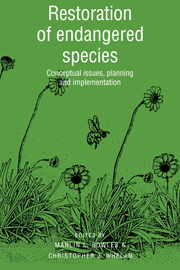Book contents
- Frontmatter
- Contents
- List of contributors
- Foreword
- Acknowledgments
- I Conceptual issues in restoration ecology
- II Restoration planning
- III Implemented restorations
- 10 The swift fox reintroduction program in Canada from 1983 to 1992
- 11 Restoration of the endangered black-footed ferret: a twenty-year overview
- 12 Development and implementation of a recovery program for the federally threatened Lakeside daisy (Hymenoxys acaulis var. glabra)
- 13 Demographic monitoring and the recovery of endangered plant populations
- IV Synthesis and future directions: biology, politics and reality
- Taxonomic Index
- Subject Index
13 - Demographic monitoring and the recovery of endangered plant populations
Published online by Cambridge University Press: 27 January 2010
- Frontmatter
- Contents
- List of contributors
- Foreword
- Acknowledgments
- I Conceptual issues in restoration ecology
- II Restoration planning
- III Implemented restorations
- 10 The swift fox reintroduction program in Canada from 1983 to 1992
- 11 Restoration of the endangered black-footed ferret: a twenty-year overview
- 12 Development and implementation of a recovery program for the federally threatened Lakeside daisy (Hymenoxys acaulis var. glabra)
- 13 Demographic monitoring and the recovery of endangered plant populations
- IV Synthesis and future directions: biology, politics and reality
- Taxonomic Index
- Subject Index
Summary
Introduction
The recovery of endangered plants requires that natural populations be within protected, appropriate habitat and able to maintain themselves over long periods of time. Protected natural populations contain the subtle genetic and ecological characteristics that reflect the evolutionary history of a species. In extreme cases, recovery may also require the creation of new self-maintaining populations within the species' historic range and the enhancement of small natural populations in situ. Created populations reduce the probability that the species will become extinct, and restore it to a greater ecological potential. Enhanced natural populations are larger, less likely to lose their genetic variability, and less susceptible to small-scale perturbation. No plant taxa have, in fact, been recovered and consequently regarded as conserved in situ, despite numerous attempts to protect (e.g. Elias 1987), create (e.g. Brookes 1981, Morgan & Wilson 1981, Griggs & Jain 1983, Havlik 1987, Falk 1988, Simonich & Morgan 1990, Reichenbacher 1990, Olwell et al. 1987, Olwell, Cully & Knight 1990, Pavlik et al. 1993b, DeMauro, chapter 12 of this volume) or enhance (Given 1983, Ferreira & Smith 1987, Pavlik & Manning 1993) populations. Under the United States' Endangered Species Act, recovery would lead to downlisting (changing from endangered to threatened status) or delisting (removing protected status) if the minimum number of viable populations were acheived (Bartel 1987, Knudsen 1987, Rohlf 1991). Recovery projects have fallen short for a variety of reasons. Some have not established whether the natural, new, or enhanced populations can maintain themselves in the wild.
- Type
- Chapter
- Information
- Restoration of Endangered SpeciesConceptual Issues, Planning and Implementation, pp. 322 - 350Publisher: Cambridge University PressPrint publication year: 1994
- 30
- Cited by



